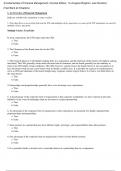Resume
Summary Strategy, HRM & Performance for oral exam Seminar HRS
- Cours
- Établissement
- Book
Summary of the chapters 2-5 from the book Strategy, HRM & Performance, a contextual approach, from Paauwe and Farndale (2017, ISBN: 8602). Used for the oral exam for the course 'Seminar Human Resource Studies (Seminar HRS)'. All the information you need is in here, together with some definitions an...
[Montrer plus]













